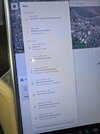Right, and I had seen that - I didn't have an issue with the premise that the parking brake had errored out b/c of water intrusion from a leaking o-ring.My last quote was a search result. Adding "weather" after seeing Nate75D rain issue.
The problem with that is with the motors disconnected, the problem SHOULD have been confined to an error about the parking system. That's what a logical person would think at least. The thought never occurred that with all the modules connected properly, and only the parking brake motors disconnected, that the car's communication system would go completely haywire.
Why would ALL the communication in the car depend on two cheap Chinese motors being connected in parallel with the rest of the wiring? That makes no sense. Hence all the problems diagnosing this, b/c the errors were intermittent and seemingly unrelated to the ONE known issue that had started it all.
Even now, I'm still not 100% that replacing those motors will solve the rest of it, b/c everything has been so intermittent.
Heck - on my MX, I had an isolation error a few days ago, that ALSO went away shortly after, and has not reappeared. That's ALSO not a comforting thing, b/c it can (and should) brick the car if it is an actual safety hazard.



